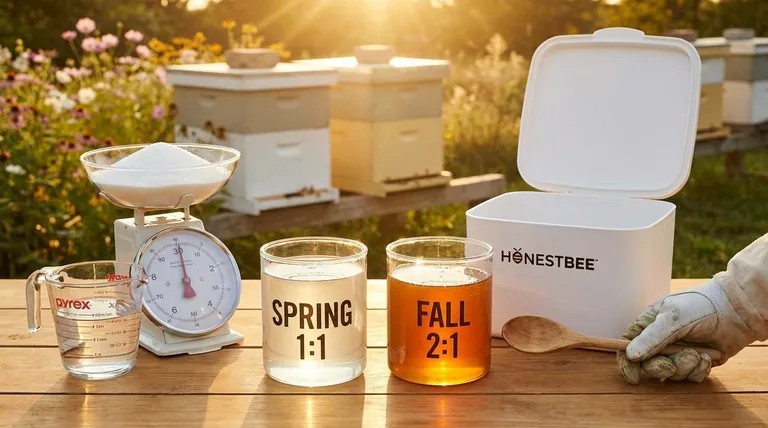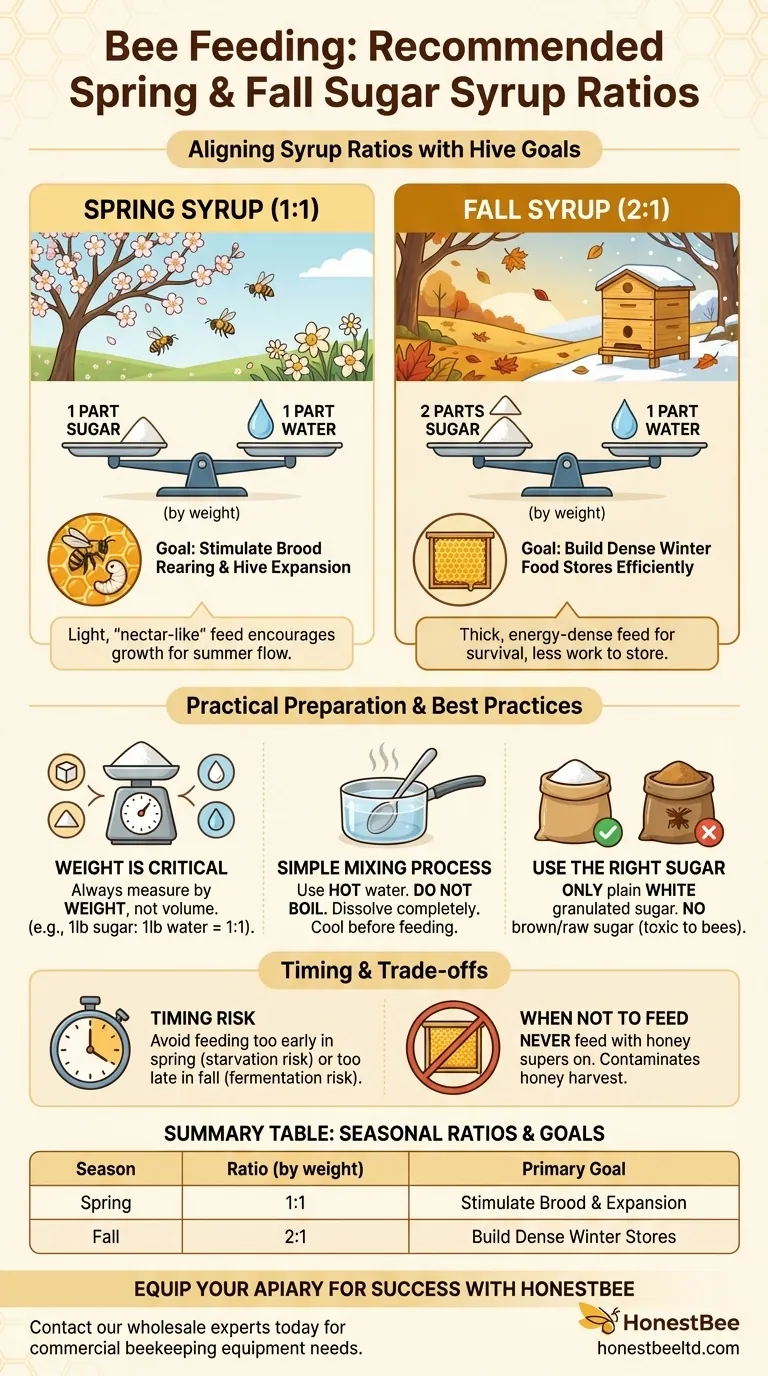In beekeeping, the season dictates the syrup. The standard sugar syrup ratio for spring feeding is 1:1 (one part sugar to one part water, by weight), which stimulates hive growth. For fall, the ratio changes to 2:1 (two parts sugar to one part water, by weight) to help bees build dense food stores for winter.
The difference between spring and fall syrup ratios is not about the ingredients, but the goal. A light 1:1 syrup mimics a natural nectar flow to encourage expansion, while a thick 2:1 syrup provides a dense, easy-to-store energy source for winter survival.

The "Why" Behind the Ratios: Aligning with the Hive's Goals
The concentration of sugar syrup sends a distinct signal to the honey bee colony. As a beekeeper, you use these ratios to work in harmony with the bees' natural seasonal cycles.
Spring Syrup (1:1 Ratio): Stimulating Growth
In the spring, your goal is to encourage the queen to lay eggs and the workers to build out new comb. A 1:1 light syrup closely mimics the consistency of natural nectar from early spring blossoms.
This "nectar-like" feed triggers the bees' expansion instincts. It signals that resources are plentiful, prompting the colony to grow its population in preparation for the main summer honey flow.
Fall Syrup (2:1 Ratio): Building Winter Stores
In the fall, the objective shifts from growth to survival. The colony must store enough food to last through the long, cold winter when no forage is available. A 2:1 heavy syrup is the ideal tool for this.
This dense mixture has a much higher sugar content. This means the bees expend less energy and water to dehydrate the syrup and convert it into "honey" for storage in the comb. It is a highly efficient way to deliver maximum calories.
Practical Preparation and Best Practices
Accuracy and cleanliness are critical when preparing sugar syrup. Mistakes can be ineffective at best and harmful at worst.
Measuring by Weight is Critical
Always measure your sugar and water by weight, not volume. A cup of granulated sugar weighs significantly less than a cup of water, so using volumetric measurements will result in an incorrect ratio. A simple kitchen scale is your most important tool.
- 1:1 Syrup: Combine 1 pound of sugar with 1 pound of water (which is 2 cups).
- 2:1 Syrup: Combine 2 pounds of sugar with 1 pound of water.
A Simple Mixing Process
Use hot water from the tap to help dissolve the sugar more easily. Do not boil the water or the syrup. Boiling or scorching sugar can create hydroxymethylfurfural (HMF), a compound that is toxic to bees.
Simply stir the white sugar into hot water until the solution is completely clear. Allow the syrup to cool completely to room temperature before giving it to your bees.
Use the Right Sugar
Only use plain white granulated sugar (cane or beet sugar). These are nearly pure sucrose, which is what bees process from nectar.
Never use brown sugar, raw sugar, or molasses. These contain solids and compounds that bees cannot digest, which can lead to dysentery and kill the colony, especially during winter confinement.
Understanding the Trade-offs and Timing
Supplemental feeding is a powerful management tool, but it is not without risk. Proper timing is everything.
The Risk of Feeding Too Early or Late
In spring, feeding too early can stimulate a massive population boom before natural forage is available, leading to starvation.
In fall, feeding must be completed early enough for the bees to process and cap the syrup before cold weather arrives, typically by the end of September in northern climates. Syrup fed too late will ferment in the feeders.
When Not to Feed Syrup
Feeding is a supplement, not a replacement for natural forage. Never feed syrup while you have honey supers on the hive that are intended for human consumption. Doing so will contaminate your honey harvest with sugar water.
If a hive is strong and there is a heavy natural nectar flow, supplemental feeding is unnecessary and wasteful. Only feed when the colony truly needs support.
Making the Right Choice for Your Goal
Your decision to feed and what ratio to use should always be based on a clear objective and an assessment of your hive's specific needs.
- If your primary focus is stimulating a new or weak hive in spring: Use a 1:1 ratio to encourage brood rearing and comb construction.
- If your primary focus is ensuring a strong hive has enough food for winter: Use a 2:1 ratio in the fall to help bees rapidly build up their winter stores.
- If your primary focus is providing emergency support during a summer nectar dearth: Use a 1:1 ratio to provide both carbohydrates and hydration without overly taxing the bees.
Understanding these principles allows you to use feeding as a precise tool to support your colonies' health and productivity throughout the year.
Summary Table:
| Season | Sugar Syrup Ratio (by weight) | Primary Goal |
|---|---|---|
| Spring | 1:1 (1 part sugar to 1 part water) | Stimulate brood rearing & hive expansion |
| Fall | 2:1 (2 parts sugar to 1 part water) | Build dense winter food stores efficiently |
Equip Your Apiary for Success with HONESTBEE
Feeding your bees correctly is fundamental to a thriving operation. Having the right equipment is just as crucial. HONESTBEE supplies commercial apiaries and beekeeping equipment distributors with the high-quality, durable supplies needed for efficient feeding and hive management.
Let us help you build a stronger, more productive beekeeping business. Contact our wholesale experts today to discuss your equipment needs and volume pricing.
Visual Guide

Related Products
- HONESTBEE Professional Hive Top Bee Feeder Feeding Solution
- HONESTBEE Round Hive Top Bee Feeder for Syrup
- HONESTBEE Entrance Bee Feeder Professional Hive Nutrition Solution for Beekeeping
- HONESTBEE Advanced Ergonomic Stainless Steel Hive Tool for Beekeeping
- Rapid Bee Feeder White Plastic 2L Round Top Feeder for 8 or 10-Frame Bee Hives
People Also Ask
- What is the best way to top feed bees? A Safe, High-Volume Feeding Solution for Your Apiary
- What is a top feeder for bees? Maximize Colony Health with Efficient Feeding
- What should be done with feeders and equipment after feeding bees? Essential Steps for Apiary Health
- Why is a top feeder essential for bees? Ensure Colony Health and Efficiency
- How is the plywood floor fitted into the hive-top feeder? Ensure Longevity with a Floating Floor Design



















